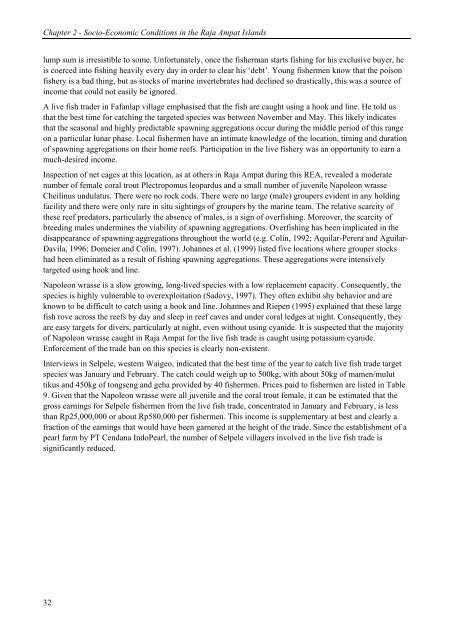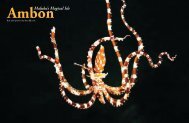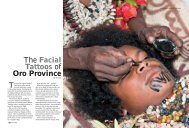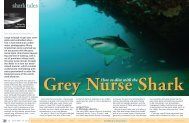Rapid Ecological Assessment - Indo-Pacific Images
Rapid Ecological Assessment - Indo-Pacific Images
Rapid Ecological Assessment - Indo-Pacific Images
- No tags were found...
You also want an ePaper? Increase the reach of your titles
YUMPU automatically turns print PDFs into web optimized ePapers that Google loves.
Chapter 2 - Socio-Economic Conditions in the Raja Ampat Islands<br />
lump sum is irresistible to some. Unfortunately, once the fisherman starts fishing for his exclusive buyer, he<br />
is coerced into fishing heavily every day in order to clear his ‘debt’. Young fishermen know that the poison<br />
fishery is a bad thing, but as stocks of marine invertebrates had declined so drastically, this was a source of<br />
income that could not easily be ignored.<br />
A live fish trader in Fafanlap village emphasised that the fish are caught using a hook and line. He told us<br />
that the best time for catching the targeted species was between November and May. This likely indicates<br />
that the seasonal and highly predictable spawning aggregations occur during the middle period of this range<br />
on a particular lunar phase. Local fishermen have an intimate knowledge of the location, timing and duration<br />
of spawning aggregations on their home reefs. Participation in the live fishery was an opportunity to earn a<br />
much-desired income.<br />
Inspection of net cages at this location, as at others in Raja Ampat during this REA, revealed a moderate<br />
number of female coral trout Plectropomus leopardus and a small number of juvenile Napoleon wrasse<br />
Cheilinus undulatus. There were no rock cods. There were no large (male) groupers evident in any holding<br />
facility and there were only rare in situ sightings of groupers by the marine team. The relative scarcity of<br />
these reef predators, particularly the absence of males, is a sign of overfishing. Moreover, the scarcity of<br />
breeding males undermines the viability of spawning aggregations. Overfishing has been implicated in the<br />
disappearance of spawning aggregations throughout the world (e.g. Colin, 1992; Aquilar-Perera and Aguilar-<br />
Davila, 1996; Domeier and Colin, 1997). Johannes et al. (1999) listed five locations where grouper stocks<br />
had been eliminated as a result of fishing spawning aggregations. These aggregations were intensively<br />
targeted using hook and line.<br />
Napoleon wrasse is a slow growing, long-lived species with a low replacement capacity. Consequently, the<br />
species is highly vulnerable to overexploitation (Sadovy, 1997). They often exhibit shy behavior and are<br />
known to be difficult to catch using a hook and line. Johannes and Riepen (1995) explained that these large<br />
fish rove across the reefs by day and sleep in reef caves and under coral ledges at night. Consequently, they<br />
are easy targets for divers, particularly at night, even without using cyanide. It is suspected that the majority<br />
of Napoleon wrasse caught in Raja Ampat for the live fish trade is caught using potassium cyanide.<br />
Enforcement of the trade ban on this species is clearly non-existent.<br />
Interviews in Selpele, western Waigeo, indicated that the best time of the year to catch live fish trade target<br />
species was January and February. The catch could weigh up to 500kg, with about 50kg of mamen/mulut<br />
tikus and 450kg of tongseng and geha provided by 40 fishermen. Prices paid to fishermen are listed in Table<br />
9. Given that the Napoleon wrasse were all juvenile and the coral trout female, it can be estimated that the<br />
gross earnings for Selpele fishermen from the live fish trade, concentrated in January and February, is less<br />
than Rp25,000,000 or about Rp580,000 per fishermen. This income is supplementary at best and clearly a<br />
fraction of the earnings that would have been garnered at the height of the trade. Since the establishment of a<br />
pearl farm by PT Cendana <strong>Indo</strong>Pearl, the number of Selpele villagers involved in the live fish trade is<br />
significantly reduced.<br />
32





